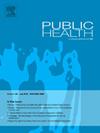An ecological approach to understanding the multilevel risk factors of youth suicidality in the United States
IF 3.2
3区 医学
Q1 PUBLIC, ENVIRONMENTAL & OCCUPATIONAL HEALTH
引用次数: 0
Abstract
Objectives
Although suicidality (e.g., suicidal ideation, planning, and attempts) is highly prevalent among adolescents in the United States (U.S.), few studies have explored the interrelationships of societal, community, family, and individual risk factors that collectively contribute to youth suicidality. This study aimed to estimate the complex interplay of multilevel factors associated with youth suicidality in the U.S., stratified by sex.
Study design
Population-based cross-sectional study.
Methods
Using data collected from a nationally representative sample (N = 17,263, 48.0 % female) in 2023, multigroup structural equation modeling was used to assess the direct effects and indirect pathways of social disadvantage, family adversity, and violence victimization on self-report suicidality (ideation, planning, and attempts) among male and female adolescents.
Results
Social disadvantage, family adversity, and violence victimization were intercorrelated and collectively contributed to youth suicidality, with sex-specific patterns. Among males, violence victimization showed the strongest direct and total effects on suicidality. Among females, however, family adversity had the strongest direct effect while social disadvantage showed the strongest total effects on suicidality. The correlation between violence victimization and suicidality was statistically stronger in males, whereas social disadvantage was more strongly correlated with family adversity in females.
Conclusions
To address the intercorrelated, multilevel factors associated with youth suicidality, comprehensive strategies and sex-specific protocols are needed. For males, it is recommended to screen for a broad range of violence victimization to facilitate early identification of at-risk groups. For females, addressing the impact of social disadvantage and family adversity is essential to reduce the risk of suicidality.
用生态学的方法来了解美国青少年自杀的多层次危险因素
虽然自杀行为(如自杀意念、自杀计划和自杀企图)在美国青少年中非常普遍,但很少有研究探索社会、社区、家庭和个人风险因素之间的相互关系,这些因素共同导致青少年自杀。本研究旨在估计与美国青少年自杀相关的多层次因素的复杂相互作用,并按性别分层。研究设计:基于人群的横断面研究。方法利用2013年全国代表性样本(N = 17263,女性48.0%)的数据,采用多群体结构方程模型,评估社会劣势、家庭逆境和暴力受害对男女青少年自我报告自杀(意念、计划和企图)的直接影响和间接途径。结果社会劣势、家庭逆境和暴力受害三者相互关联,共同导致青少年自杀,且存在性别差异。在男性中,暴力受害对自杀的直接和总体影响最强。然而,在女性中,家庭逆境对自杀的直接影响最大,而社会逆境对自杀的总影响最大。暴力受害与自杀的相关性在男性中更强,而在女性中,社会劣势与家庭逆境的相关性更强。结论为了解决与青少年自杀相关的相互关联的多层次因素,需要综合策略和针对性别的方案。对于男性,建议进行广泛的暴力受害筛查,以促进早期识别风险群体。对女性来说,处理社会不利地位和家庭逆境的影响对于减少自杀风险至关重要。
本文章由计算机程序翻译,如有差异,请以英文原文为准。
求助全文
约1分钟内获得全文
求助全文
来源期刊

Public Health
医学-公共卫生、环境卫生与职业卫生
CiteScore
7.60
自引率
0.00%
发文量
280
审稿时长
37 days
期刊介绍:
Public Health is an international, multidisciplinary peer-reviewed journal. It publishes original papers, reviews and short reports on all aspects of the science, philosophy, and practice of public health.
 求助内容:
求助内容: 应助结果提醒方式:
应助结果提醒方式:


